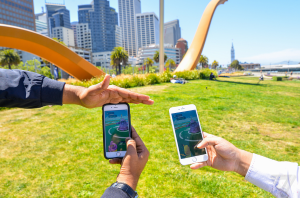
It can be hard for adults to keep up with the latest digital trends that children and young people are into. Pokemon Go is suddenly everywhere, just as the Pokemon characters are everywhere around us.
For readers who haven’t heard what it is: “Explore cities and towns around where you live and even around the globe to capture as many Pokémon as you can. Also look for PokéStops located at interesting places, such as public art installations, historical markers, and monuments, where you can collect more Poké Balls and other items.” It uses GPS to track you, and on the screen you see a virtual map of the world around you. And this BBC article tells you everything you need to know.
Apparently, Pokemon Go is getting players into cultural venues and around heritage sites, and connecting with strangers in those places, in ways that haven’t been seen with other mobile apps. In addition, it’s already being used successfully by teachers to motivate children with autism to explore places and learn where they might otherwise lack confidence. So, how long will it last? Is it just a craze? Will it have an impact on learning and creativity in the future? Should cultural organisations jump on the bandwagon?
Martha Henson argues here that museums shouldn’t try to recreate something like Pokemon Go, but could possibly try doing something much smaller and more focused. Museums and other cultural organisations certainly can acknowledge its appeal, for example, welcoming young people that come in to ‘poke’ even if they’re not looking much at the art. Her post includes lots more links if you’re interested.
Donald Clark takes it quite a bit further, and more optimistically looks forward. He thinks that the success of Pokemon Go portends 10 potential uses of Alternate Reality technology in learning. He thinks that this shows that Virtual Reality, ironically, has potential to really extend learning into the real world. It illustrates that it would be possible to build applications that provide in-depth explanation of phenomena encountered by learners, to encourage learning through problem-solving, to learn by doing, to learn more socially, to be guided by tutors as avatars, to form better habits, to improve through practice, to challenge people to be prepared for extreme situations through simulations, to improve assessment of learning on the go, and to basically provide a breakthrough in the much heralded M-learning.
What do you think are the possible implications of this kind of successful game, in terms of the future of learning and culture? What would you build on top of this kind of technology and where might it take us?
Great read.
LikeLike